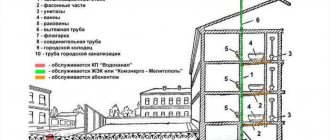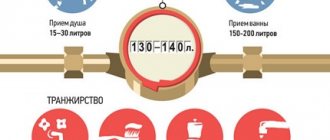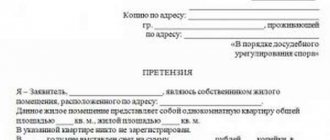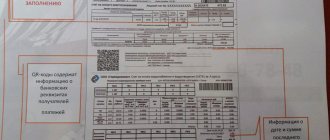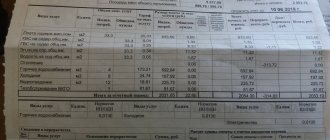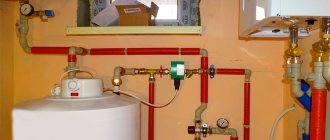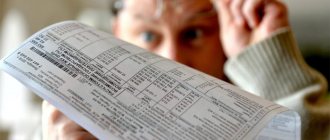Residents of apartment complexes in many Russian regions are faced with such a problem as the appearance of the column “Payment for sewerage at one-way service station” in housing and communal services receipts. This term includes both the discharge of water used by residents into sewers and other water services. But not everyone knows in what cases this payment is charged, how it is calculated and to whom to complain about its illegal collection.
Rationing is the basic rule of any calculations
Each region has its own standards for water consumption (drinking, for sanitary and hygienic needs, for everyday life and household use).
This is explained by different geographical locations and weather factors. Let’s take the daily norms of volumetric parameters of water consumption and wastewater disposal, distributed for household and household needs. Let's not forget that they are the same in terms of water supply and disposal, but depend on how comfortable the home is.
Standard water consumption values:
- with an outdoor water stand - from 40 to 100 liters per person;
- apartment-type residential building without bathrooms – 80/110;
- the same with baths and gas heaters - 150/200;
- with centralized cold and hot water supply – 200-250.
There are also water consumption standards for caring for pets and poultry. They include costs for cleaning pens, cages and feeders, feeding, etc. 70-100 liters are provided for a cow, 60-70 liters for a horse, 25 liters for a pig, and only 1-2 liters for a chicken, turkey or goose.
Due to a small water leak, water supply costs will increase significantly. Some reserve for unexpected water consumption is better than the fate when performing the balance calculation (+)
There are standards for the operation of vehicles: tractor equipment - 200-250 liters of water per day, car - 300-450. It is necessary to plan water consumption for fire extinguishing for all buildings and structures, regardless of operational purpose. Even for gardening societies there is no exception: the water consumption rate for extinguishing a fire outside is 5 liters per second for 3 hours, for an internal fire - from 2 to 2.5.
Water for fire extinguishing is taken from the water supply. Fire hydrants are placed on water pipes in wells. If this is not technically feasible or unprofitable, then you will have to take care of a reservoir with a supply of water. This water must not be used for other purposes; the period for restoring the supply in the reservoir is three days.
Irrigation water consumption per day: 5-12 l/m2 for trees, shrubs and other plantings in open ground, 10-15 l/m2 – in greenhouses and greenhouses, 5-6 l/m2 – for lawn grass and flower beds. In industry, each industry has its own characteristics of rationing water consumption and waste disposal - pulp and paper production, metallurgy, petrochemicals, and the food industry are water-intensive.
The main purpose of rationing is to economically justify the norms of water consumption and drainage for the purpose of rational use of water resources.
During a day off (cleaning the apartment, washing, cooking, bathing in the shower and bath), the average daily water consumption can be exceeded 2-3 times (+)
Calculation of drainage in an apartment building
Each citizen of the Russian Federation living in an apartment building pays for the sewerage of his own apartment, plus for sewerage for general building needs (GDN). In some apartment buildings, drainage meters are installed - KPU (collective metering devices), which show the general volume of drainage.
If this volume is greater than the sum of the amount of individual consumption for each apartment, then the remainder was distributed among the residents in proportion to the area of the apartment. In the same apartment buildings where there are no meters for single-use water supply systems (and these are the majority), residents are not required to pay for sewerage to the single-room supply system, since, according to the Decree of the Russian Federation of April 16, 2013 number 334, there are no standards for sewerage for general building needs.
On January 1, 2021, Decree of the Government of the Russian Federation dated December 26, 2016 No. 1498 “On issues of providing utilities and maintaining common property in an apartment building” came into force.
This resolution establishes that before June 1, 2017, regional authorities of the Russian Federation must determine and approve standards for general building needs in an apartment building, so that in 2018 they should already be determined everywhere.
Examples of calculations for wastewater disposal
- Cold water consumption according to the cold water meter is 8 m3;
- Hot water consumption according to the DHW meter – 12 m3;
- The tariff for sewerage is 25 rubles.
Then the volume of water used is equal to: 8 m3 + 12 m3 = 20 m3. And the fee for drainage will be: 20 m 3 * 25 rubles. = 500 rub.
Every year the amounts in receipts for payment of housing and communal services are growing. If the organization of legal relations with management companies follows the same trend, conditions for consumers are unlikely to improve. We can only hope that the Russian government will someday adopt regulations and laws that will reduce utility bills.
Additional Information:
Drainage is the sum of DHW (hot water supply) and cold water supply (cold water supply). It is believed that as much as it comes, so much goes back. Toilet flush - drainage; Did you swim? — water disposal. We washed the dishes - also drainage. All water that flows through the meters to you is considered wastewater.
As for drainage, it consists of removing used water. Simply put, water disposal is the purification of already used water and its further disposal through sewerage. This housing and communal services service is mandatory for payment by all residents of the city: from apartment owners to owners of private houses.
They depend on the management company, the region, and other factors. Tariffs are set in compliance with certain criteria: category of liquid waste and wastewater, water quality, and so on.
The estimated volume of the communal resource is determined on the basis of an agreement for the supply of cold water supply concluded between the contractor and the resource supplying organization, in the absence of such an agreement, by a calculation method established in accordance with the requirements of the legislation of the Russian Federation on water supply.
The calculation of labor costs and social contributions from the wage fund for inclusion in the water tariff is carried out on the basis of the norms of the current legislation of the Russian Federation, the staffing table, the Regulations on wages, the Collective Agreement, orders for additional payments, combinations and other local acts of the regulated organizations.
For example, residents of an apartment building decided to independently clean the territory, water the land, monitor the condition of the entrances, and also fulfill other needs. They should first be calculated. For all this, a certain consumption of liquid (possibly a certain number of hot liters) is used for general house needs. There is a certain standard for how many cubes there should be.
Calculating payment for water using a meter involves adding up charges based on the readings of an individual meter and a proportional part of charges for a common household meter.
Source
How to avoid paying for sewerage
Payment for sewerage is mandatory for all citizens living in Russia, and cancellation is not provided.
However, on April 16, 2013, the Government of the Russian Federation issued Resolution No. 344, according to which the determination of the standard for wastewater disposal for general house needs is canceled. Consequently, now the payment for the removal of water for public use should not be included in the receipt (unless otherwise specified in the agreement with the water utility or management company). Otherwise, consumers have the right to file a lawsuit against the violators and demand a recalculation, taking the volume of consumption according to the meter as a basis.
Tariffs and calculation of sewerage in an apartment building
Legal aspect of charging for sewerage
The tariff for sewerage is set taking into account various parameters. There is no single tariff in Russia; each region has its own values. To calculate the amount of payment for sewerage, the following parameters are taken into account:
- Payment of wages to water utility employees.
- Weather and climatic conditions of the region.
- Remuneration for emergency specialists and formed teams who maintain the optimal condition and uninterrupted functioning of backbone networks. A separate fee will be charged for the section of water supply that needs repair.
- Current condition of sewer lines.
- Number of users of provided housing and communal services.
- Assessing the performance of central water supply and sanitation networks.
- The number and productivity of pumping stations, as well as their distance from places of final consumption.
- Distance of drains and water pumping.
It is also worth familiarizing yourself with the 3 main methods of calculating drainage:
- on general standards;
- Each apartment or country house has individual accounting devices, which determine the volume of natural resources consumed;
- The consumption is determined based on the indicators of the common house meter.
Calculation of water disposal by meters
Example of calculation of water disposal by meters:
- Data from measuring instruments are compared. For example, last month the readings were 30, and this month they are 60.
- The consumed volume of cold and hot water is calculated: 60-30 = 30 cubic meters.
- Calculation of the amount of sewerage by multiplying by the regional tariff plan: 30 * 9.42 = 282.6 rubles.
As an example, the tariff rate of the city of Krasnoyarsk was considered. There is no need to describe the calculation algorithm in detail on the receipt; it is enough to indicate the amount and the difference in readings between the previous and current month.
Cases of obvious overuse of water resources are also common. The situation is unpleasant because it negatively affects the family budget. The reasons for this may be:
- Leakage in water riser pipes.
- “Bad neighbors” refuse to show the reliable amount of wasted water resources.
- An unknown number of persons who are not registered at a specific address, but in fact live. It follows that they use the services, but do not pay for them.
How to pay for sewerage
Like any other utility services, you must pay a fee per calendar month for sewerage to your apartment. The payment deadlines are quite clear. At the end of the reporting period, a receipt is sent to the consumer, indicating the amount due. Rent must be paid by the 20th day of the month following the reporting month.
Otherwise, defaulters who owe money will be subject to penalties in the form of a fine for each day of late payment. Delaying payment will entail consequences, since the water utility will consider that its interests have been violated.
What is sewerage and water supply in utility bills?
Features of the water supply system: It is quite a difficult task to provide water to a multi-storey building, since the building includes a large number of apartments with autonomous sanitary equipment.
The water supply system is an engineering system with pipe distribution, water pressure control devices, as well as metering units and filters.
Often, residents of multi-storey buildings use a central water supply system.
Now there are few consumers of utility services who do not understand the tables and figures indicated on the receipt.
But there are two seemingly similar points in this document related to the word “water”:
- Water supply. In another way - hot water supply (hot water supply) and cold water supply (cold water supply). The utility service provider ensures an uninterrupted 24-hour supply of cold and hot water to citizens' residential premises. Purified water is supplied in accordance with standards. Hot water is heated to the required temperature;
- Drainage. Housing and communal services ensure the constant uninterrupted removal of used domestic water waste through a network of sewer pipes with subsequent disposal and treatment.
As a result, drainage is no less important on the payment receipt than hot and cold water. After all, a huge mass of contaminated spent water must be transported, driven through treatment facilities and disinfected before being released into natural reservoirs or used again for technical needs.
Payment for water supply and sanitation, consumption standards, tariffs and calculations
In most cases, the management company receives payment for water supply and sewerage services. Occasionally, this happens when residents of a building come to an agreement to pay directly to suppliers for these services.
Payment for water is made monthly depending on the volume of consumption. It is accepted that the amount of hot and cold water used is equal to the amount of water flushed down the drain.
Tariffs for water supply and sanitation are set in each region of the Russian Federation by their own local authorities. The amount of tariffs directly depends on the degree of deterioration of the sewage disposal system, the condition of treatment facilities and various technical disposal equipment, as well as on the presence and size of emergency teams and other service personnel in a particular locality.
How does it work in practice?
As mentioned above, such a calculation is made according to the formula: P = S x V x T. This means that if the area of the room is 34 square meters, the amount of thermal energy consumed on average is 0.085 Gcal, and the tariff for heating supplied to the room is 1371, then 34 x 0.085 x 1371 = 3962.1 rub.
2 Reply from Gus-Khrustalny 2013-01-24 00:40:50:
- Gus-Khrustalny
- Participant
- Inactive
Do not forget that if a heat meter is installed in the building, then the management company must make all calculations in the shown way and not otherwise.
In such a situation, the payment calculation procedure should consist of several steps. First, you should coordinate the total area of the real estate with the size of the specific non-residential premises.
Then everything is done like this:
- The readings of the common house meter are reconciled at the beginning and end of the paid period of time.
- The resulting difference should be considered the total energy consumption of the MKD.
- Next, the ratio of the area of the room and the size of the entire structure is calculated.
- The value of the heat tariff is determined. Such information can be obtained from an authorized employee of the management company.
Calculation of wastewater consumption in an apartment building according to standards
The amount of payment for utilities is calculated based on the volume of consumed utilities, determined by the readings of metering devices, and in their absence, based on the standards for the consumption of utilities (Part 1 of Article 157 of the Housing Code of the Russian Federation).
The provisions of this article include within the powers of the Government of the Russian Federation the establishment of rules for the provision, suspension and limitation of the provision of utility services to owners and users of premises in apartment buildings and residential buildings, as well as the approval of the procedure for establishing and determining standards for the consumption of utility services.
How are tariffs determined?
In order to consume resources wisely and be able to determine the legality of charging, you should know how tariffs for utility services are formed in the Russian Federation.
The owner of residential space in an apartment building must pay for:
- actual utilities: hot water supply (not in all houses);
- cold water supply;
- heating;
- water disposal (sewage) and so on;
The amount of payment is regulated by authorized government bodies, based on the volume of consumption and the tariff of the utility resource. In this case, the tariff refers to the cost of a unit of resource - water, electricity or gas. Volumes are calculated based on monthly average data.
Find out in more detail what the calculations are based on and who sets utility rates.
Definition of concepts
Many Russians use the word drainage to mean sewage that flows through pipes to designated areas. However, you need to understand that used water not only flows somewhere, but also goes through complex technological processes.
The concept of drainage in housing and communal services includes several stages of sewage disposal:
- removal of hot and cold water through sewer networks after its use;
- disposal of filtered waste;
- transportation to water treatment plants;
- purification of consumed water;
- collection and removal of water resulting from precipitation.
Since all communications for drainage are municipal and industrial facilities, there are costs to maintain them in working condition. Therefore, consumers are required to pay for this type of service.
At the legislative level, relations between public utilities and tenants are regulated by the Federal Law of December 7, 2011 “On Water Supply and Sanitation.” Its norms relate to water supply and sanitation.
Receipt with an error in favor of the management company
The main reason for inflating utility bills is to write off other people's debts at your expense. The management company charges additional amounts to taxpayers in order to reduce the amount of the principal debt on utility bills. They rely on the fact that most ordinary citizens pay their rent automatically, without thinking or checking their payment receipts.
Prevention in the fight against inflated utility bills is a careful check of each receipt for errors.
The best way to identify errors is to compare old receipts with new ones.
If you find errors in receipts or the presence of non-existent services, you must contact the management company with a written request to recalculate utility bills.
You can request a recalculation of a receipt on the following grounds:
- Inflated housing and communal services tariffs;
- Payment of non-existent workers;
- Payment for non-existent services;
- If the services indicated in the receipt were not actually performed by the management company.
As practice shows, in order to avoid litigation, management companies meet service users halfway and recalculate.
Individual meters installed for hot and cold water consumption will help reduce the risk of overpaying for housing and communal services. In this case, the service user will pay utilities only for the amount of water that he actually used. In houses that do not have individual water meters, utility bills are calculated based on average indicators, which gives Management Companies a reason to charge extra cubic meters of water.
Determination of storm drains
To avoid the unpleasant consequences of flooding the site with precipitation water, it is necessary to lay a storm drain with sufficient capacity. To do this, you need to calculate the volume of rainwater runoff.
Finding the average annual flow
The volume of average annual precipitation is calculated by summing the volumes of rain, irrigation and washing (relevant for the city) and melt water:
W = WD + WT + WM
For each rainwater collection area, the volume is calculated taking into account the type of surface of individual areas (roof, asphalt, lawn...), for which runoff coefficients are used that take into account the characteristics of collection, for example, the absorption of a certain amount of water by the lawn (see Table 1).
When calculating melt water, it is taken into account that surfaces are capable of partially absorbing melted water during thaws, for which a runoff coefficient ΨT is introduced, taken equal to 0.5-0.7. KU can also be used - a coefficient that takes into account the removal of cleared snow from areas.
For each site, water collection is calculated separately, the collection volumes are summed up
In addition, the location of the site is taken into account, since the amount of precipitation varies for different regions, which is taken into account when calculating by multiplying by the height of the sediment layer HD or LT (in mm). Data is taken from SP 131.13330
Formula for calculating the volume of rainwater:
WD = 10 HD * F * ΨD
The volume of annual melt water collection is calculated using the formula:
WT = 10 NT * ΨT * KU * F
The average annual collection figure is useful for determining the required capacity of a collector pond (which can be used as a fire pond or for irrigation).
Calculation of rainfall for a section of a storm system
The water flow consists of the influx of precipitation collected from the roof of the building and the territory of the site through:
- gutters,
- linear drainage systems,
- storm water inlets.
The listed areas (water collection links) have their own characteristics, so each of them collects water from its territory in its own way. This is reflected by introducing coefficients that take into account the existence of various terrain conditions, for example, greater or lesser absorption of falling moisture by the surface. Water from several areas can be collected in a separate nearby well. From individual wells, water flows into a single collection point - a collector or main storage well.
For each site, the amount of rainfall is calculated using the formula:
Q = q20 ∙ F ∙ φ
- q20 – coefficient that takes into account the average intensity of precipitation falling in a particular region, calculated based on long-term observation data (taken from the SP or from meteorologists),
- F is taken to be equal to the area of the site for which the volume of rainwater runoff is calculated (for the roof, the drainage area is calculated with a 30% addition to the total area of the walls.);
- φ – coefficient depending on the prevailing type of surface coverage on the site (values are given in Table 2).
Hydraulic calculations of storm drains are also carried out in the event of a pressure regime. For this purpose, coefficient b is used, which takes into account the fullness of the watercourse and depends on the duration of rain (see Table 3). The value of n depends on the geographical location of the object.
Qн = Q * b
Calculation of rainwater flow using the limiting intensity method
To determine the flow rate of discharged water masses in rainwater sewer collectors, the calculation of runoff is carried out taking into account the relationship between the duration of rain and the estimated intensity of precipitation.
The essence of the method is as follows: the flow of storm masses in the collector reaches its maximum value in the case when the duration of the calculated precipitation is equal to the time of flow of sedimentary water to the collector section chosen for the calculation. For each section of the collector, the duration of water flow is first determined. According to this duration, the specific rain intensity is calculated. Since with this calculation method the pipe diameters are unknown (and the water flow velocities in the cross section are also unknown), the calculation has an iterative nature.
This calculation is carried out using a formula that takes into account the surface characteristics of the runoff basin, the results of processing rain gauge records over many years, the duration of the flow of rainwater to the calculated area, the estimated runoff area, and the climatic conditions of the area:
A hydraulic calculation is made for the maximum loaded section of the collector. The pressure mode is taken into account by multiplying Qcalc by coefficient ß.
Qcalc = ß * Q
It is better to entrust this calculation, as well as the design of drainage systems, to specialists. Then the sewerage system will be guaranteed to be calculated and designed to be optimal and reliable in operation.
Peculiarities
According to Decree of the Government of the Russian Federation No. 354 of 05/06/2011, the supply of cold and hot water and wastewater disposal are public services provided by contractors to consumers. Performers are municipal and private enterprises, consumers are owners of private houses, various organizations and enterprises.
What is included in utilities:
- Citizens are provided with high-quality cold water around the clock and uninterruptedly. Water is supplied to homes in the required volumes.
- Citizens are provided with high-quality hot water around the clock and uninterruptedly. Hot water is supplied to homes in the required volumes.
- Residents of the houses are provided with gas around the clock and uninterruptedly. Gas is supplied in the required volumes through the connected network, as well as using gas cylinders.
- Citizens are provided with thermal energy around the clock and uninterruptedly (during the heating season). They supply heat energy in the required volumes and maintain the temperature in the room not lower than the established norm.
- Electricity supply. Citizens are provided with electricity around the clock and uninterruptedly.
- Residents pay their own fees for major home repairs.
- Citizens are provided with sanitation.
What is drainage on a water bill? The services provided in 2021 are:
- Preparation and supply of cold water. The performers prepare and transport it to consumers. The water is filtered, purified, and laboratory tests are carried out. Then they service pumping stations, repair central water supply networks, and carry out complexes of work to supply water through distribution pipelines to internal consumer networks.
- Preparation and supply of hot water. Boiler rooms are serviced (here the water is heated), and the routes are maintained in working order. According to them, it is supplied to consumers. If the boiler rooms are autonomous, and the apartments have gas water heaters, there is no such service.
- Drainage. Wastewater from consumer premises is discharged into the sewer system, transported for treatment, waste is disposed of and wastewater is disposed of.
Thus, we see that drainage is the removal of wastewater from premises. This is the total consumption of hot water (hot water) and cold water (cold water), its purification and subsequent disposal using the sewer system.
The counter will help you count it. But there are no metering units for sewer networks in apartments. The KPI is indicated on the receipt for owners who pay housing and communal services for the apartment. DPU - for owners in a private house.
What is drainage in utility bills? In fact, citizens pay for the work of flushing the toilet, bathtub, and kitchen sink. All the water that goes into the apartment according to the meters is sewerage.
It is necessary to distinguish between “water supply” and “sewage” in the receipt. These are two completely different concepts. The payment for water supply includes the cost of water treatment. The hot one is heated, the cold one is disinfected. Drainage – disposal of used water.
If the house has a separate common house meter (ONE in the receipt), each of the home owners must pay for both their own needs and the needs of the house. With the help of such meters, the amount of water consumed by the entire house is determined.
Sometimes buildings are equipped with meters that determine the volume of drainage (KPU - collective metering device). Accurately shows the amount of sewer work completed.
If there is no ODN meter, changing the water supply in the receipt taking into account the consumption for general house needs is illegal. There are no standards for general household needs, and any standards applied locally are regarded as arbitrariness.
Receipt with an error in favor of the consumer
The consumer may receive receipts with reduced rates if the management company did not take into account one or more residents registered in the apartment. In this case, the receipt will indicate the amount calculated based on the old number of registered residents in the apartment.
An error in the number of registered residents will result in growing debt. In fact, unregistered residents will also use the services, so the accumulated debt will in any case fall on the shoulders of the homeowner.
Sooner or later the error will come to light. The Management Company will establish the fact of an error in the number of registered residents, and then demand compensation for losses from the owner of the property.
The management company has the right to demand payment of the accumulated debt only for the past 3 years.
This means that a homeowner who pays utilities without taking into account one of the registered residents for 5 years is obliged to pay the resulting debt for only 3 years. Accordingly, the management company is obliged to calculate the debt only for 3 years, leaving the remaining 2 years without attention.
If the management company does not agree with this provision, the user has the right to go to court.
Rate this post
Why is water disposal greater than water consumption?
On the receipt, the tariffs will look in such a way that the amount for used cold and hot water will be slightly less than the price of sewerage in the household. This may be due to several features. Namely:
- climatic conditions (in cold seasons, as well as in cold regions, payments will be charged at increased tariffs, which is due to the need for increased attention to pipelines);
- recycling and wastewater treatment is characterized by high costs;
- the need for additional use of expensive equipment, which must be promptly repaired and maintained in proper condition.
Thus, water supply requires less human power and equipment than drainage.
How to calculate the cost of a service
How many cubic meters of water a tenant uses in a month is how much he must pay. If ten cubic meters of cold water were used, then the indicator that is in the “Tariff” column must be multiplied by 10. The same with hot water. But how is the calculation for sewerage done?
Both cold and hot water are recycled. When calculating, you should multiply the tariff (sewage) by the total number of cubic meters consumed. That is, if eight cubic meters of cold water and four hot ones are used in a month, you should find the derivative from the numbers 12 and x. X is a tariff, which, as already mentioned, can be different. But in most cases it ranges from 20 to 25 rubles.
Payment for sewerage is divided by the number of residents if a common building meter is installed. Installing an individual one can significantly reduce the total amount on the receipt.
Drainage in utility bill receipts and sewerage law
All information about water disposal is specified in the RF Government Regulation No. 354 dated May 6, 2011.
The Russian Government Decree No. 354 dated May 6, 2011 describes in detail the concept of water disposal and its features. The interpretation of the term is as follows - a set of measures aimed at removing household waste and wastewater from residential premises using a centralized main sewer network.
All consumers of utility resources can receive the service. The state regulates the disposal of used water resources, and also makes changes to regulations and sets rules. Regulated by a number of regulations:
- Decrees of the Government of the Russian Federation, the content of which mentions the services provided by housing and communal services.
- Regional provisions and regulations on the basis of which the amount to be paid is calculated.
- Local changes and amendments to all structures and organizations that are related to wastewater disposal.
- Recommendations and resolutions adopted by local governments.
Metering devices
In addition to a regular water meter, you can also install a wastewater flow meter - in this case, the payment for sewerage will be calculated based on its readings. This device is installed directly on the sewer pipeline and measures how much water flows into it. There are both apartment metering devices (KPU) and common house metering devices (DPU).
First of all, installing such a device will be beneficial if you live in a private sector, where a significant portion of the water is not sent to drains, but is used, for example, for irrigation or other similar activities.
With active water consumption without draining it into the sewer system, payments for hundreds of liters can be saved per week due to the flow meter, which makes its installation absolutely mandatory - the device pays for itself in a matter of months. In an apartment, the savings will be much less noticeable, and therefore the installation of a flow meter can no longer be called so necessary.
There are two types of flow meters based on their operating principle:
- measuring the water level in the pipeline;
- measuring the level and flow rate.
A device of the first type can be used for a non-pressure collector, that is, if the drains move without pressure, solely due to the inclination of the pipe and gravity. The second type of device is used in pumping systems.
Deliberate drainage of water
Housing and communal services have the right to demand payment for intentional drainage of water only in a situation where it was made by the owner of the premises, or the noted situation occurred due to leaks and improper condition of the system in the apartment. Note that it is worth draining the water periodically, but the issue of payment remains open.
According to current standards, owners are obliged to monitor the integrity and safety of their property, and if it is determined that the drain occurred due to the owner’s negligence, he will pay. But if the sewage system is new, and everything is in order in the apartment, then the housing and communal services will pay for the intentional drainage.
If there is a deliberate drain of water by housing and communal services employees, consumers will not pay for it. If the payment slip indicates otherwise, that is, there is an unlawful charge of payment, they have the right to contact law enforcement officers with a complaint against the utility companies.
